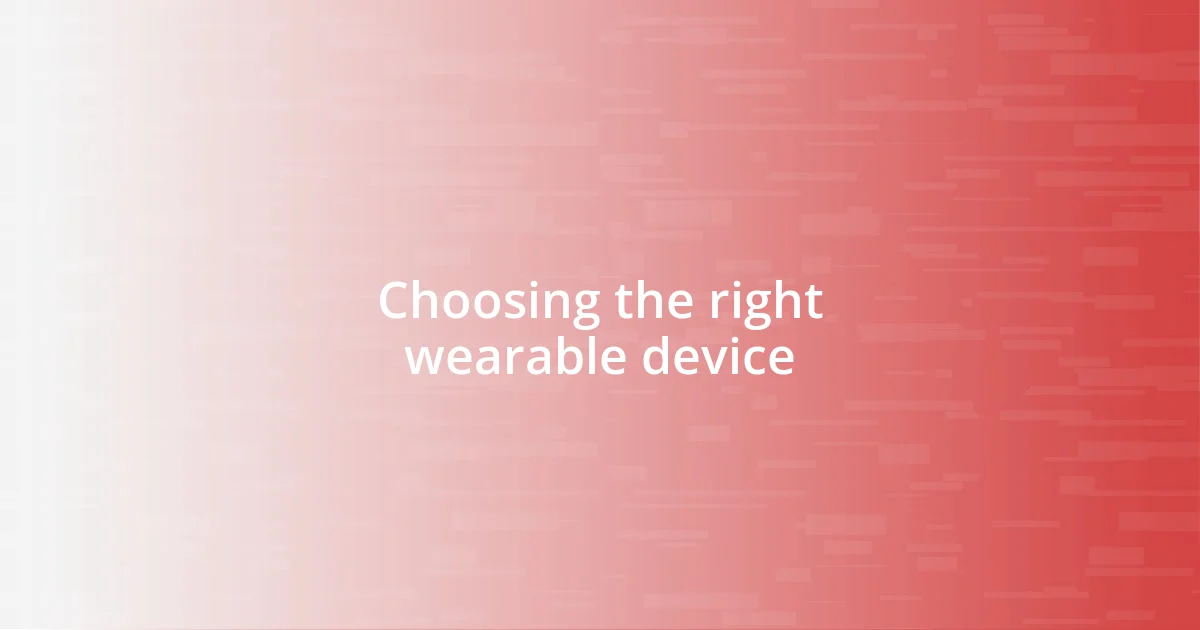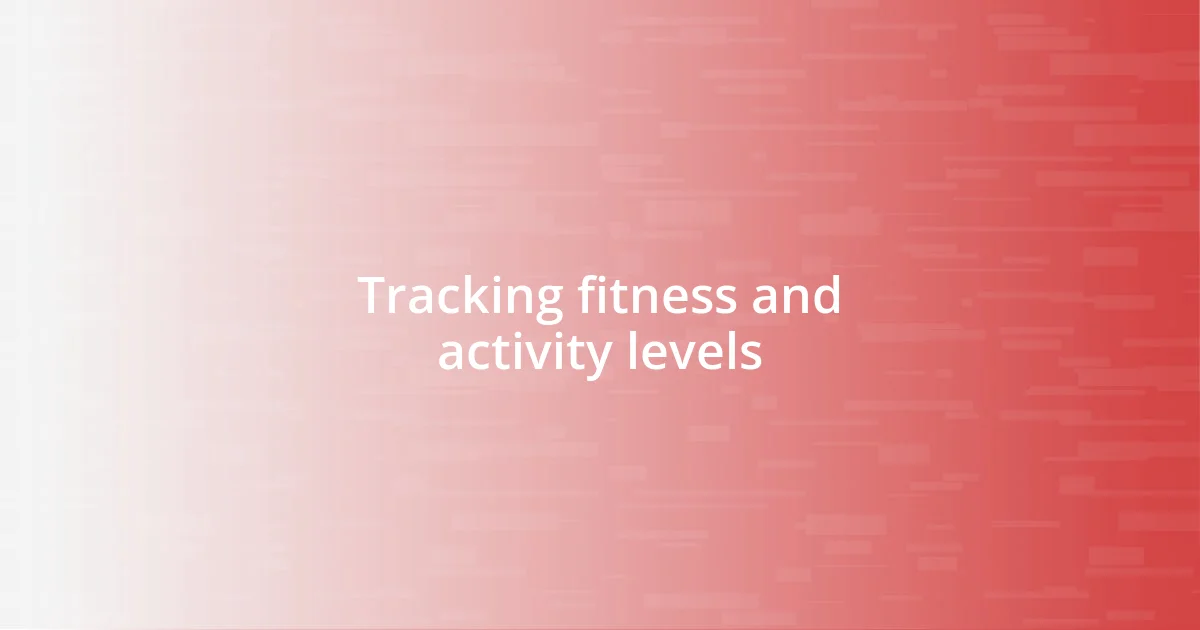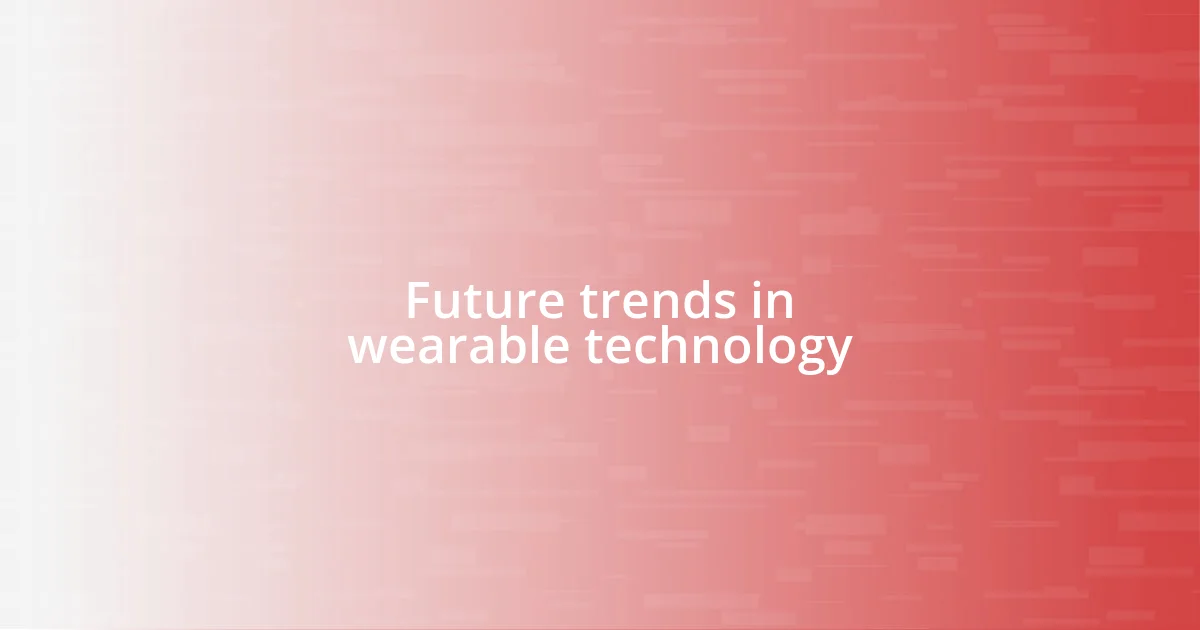Key takeaways:
- Wearable devices enhance health awareness, accountability, and data collection, significantly improving personal fitness and lifestyle choices.
- When choosing wearables, consider factors like purpose, compatibility, battery life, comfort, and pricing to ensure a good fit for your lifestyle.
- Future trends in wearables include personalized training, augmented reality integration, and connections with smart home devices, enhancing user engagement and health monitoring.

Understanding the benefits of wearables
One significant benefit of wearable IoT devices is their ability to keep us connected and informed in real time. I remember the first time I wore a smartwatch; it alerted me about my heart rate during a particularly intense workout. How often do we ignore our body’s signals? This device didn’t just help me track my fitness; it sparked a deeper awareness of my health, prompting me to listen more closely to my body.
Another advantage I’ve noticed is how wearables foster a sense of accountability. When I began using a fitness tracker, I felt compelled to reach my step goals every day. Have you ever set a goal and then let it slip away? With my wrist reminding me to move, I found extra motivation to stay active. It transformed my daily routine and made maintaining an active lifestyle not just a goal but a delightful habit.
Lastly, the potential for data collection is quite profound. I’ve been fascinated by how wearables can analyze patterns in my sleep quality. Who wouldn’t want to understand their rest cycle better? Seeing insights like restless nights or deep sleep patterns allowed me to make conscious changes, ultimately leading to more rejuvenating nights. It’s incredible to consider how much we can learn about ourselves through these devices.

Choosing the right wearable device
Choosing the right wearable device can feel overwhelming with so many options on the market. Each type offers its unique features, from advanced fitness tracking to extensive health monitoring. I remember standing in an electronics store, torn between a sleek smartwatch and a more simplistic fitness band. What ultimately swayed my decision was considering not just the features I wanted but how I planned to integrate the device into my lifestyle.
When selecting a wearable device, I’ve found it helpful to weigh a few critical factors:
- Purpose: Determine if you need it for fitness tracking, health monitoring, or daily connectivity.
- Compatibility: Ensure it syncs seamlessly with your smartphone or other devices.
- Battery Life: Consider how often you’re willing to charge the device.
- Comfort: Try it on if possible; you’ll want a device that you forget you’re wearing.
- Pricing: Set a budget while remembering that investing in a quality device can pay off in terms of longevity and features.
Taking these elements into account made my choice more focused. Now, I rarely leave home without my wearable; it’s like my trusted companion, always keeping me mindful of my health and connectivity.

Integrating wearables into daily life
Integrating wearables into daily routines can elevate our lifestyle significantly. When I first began wearing a health tracker, I found myself checking in throughout the day, not just to monitor my steps, but to assess my overall energy levels. Have you ever taken a moment to pause and reflect during your busy day? This simple act helped me recognize when I was pushing too hard or when it was time to take a much-needed break. Gradually, my wearable became a catalyst for a more balanced approach to my day.
One of the most practical ways I’ve found to integrate my smartwatch is by syncing it with my daily schedules. For instance, setting reminders to drink water or take quick walking breaks transformed mundane tasks into engaging challenges. I remember being surprised at how little things like gentle nudges could help me stay on track. Isn’t it fascinating how technology can turn routine actions into motivational moments? I genuinely appreciate how these devices adapt to my life, making healthy choices feel effortless.
Additionally, I’ve experienced the real power of wearables during social outings, where sharing fitness accomplishments added an element of camaraderie among friends. Whether it’s cheering each other on during a collective challenge or sharing our healthy habits, these interactions have deepened my connections with my circle. It feels rewarding to surround myself with like-minded individuals who inspire me to stay active. Don’t you think that fostering such connections can enhance our commitment to health and fitness?
| Aspect | Wearable Integration |
|---|---|
| Health Tracking | Monitoring daily activity and heart rate enhances awareness of fitness levels. |
| Motivation | Regular reminders encourage consistent movement and hydration. |
| Social Connection | Sharing achievements with friends fosters a supportive community. |

Monitoring health with wearables
When it comes to monitoring health with wearables, I’ve come to appreciate how these devices offer real-time insights into my well-being. Just last week, I’d been feeling unusually fatigued, and my smartwatch alerted me to a drop in my heart rate during a workout. This prompted me to slow down and reassess my usual intensity. Have you ever experienced a health scare that made you rethink your approach? That moment was a gentle reminder of how these gadgets can serve as our first line of defense in tracking significant health changes.
One of the most exciting features of my fitness tracker is its sleep monitoring capability. Initially, I was skeptical about the accuracy, but my experience has been eye-opening. After a few weeks of tracking my sleep patterns, I discovered that I was consistently restless during the night. I felt compelled to make adjustments to my bedtime routine, like limiting screen time and establishing a calming pre-sleep ritual. It’s incredible how tuning into what my body is telling me through data can lead to a more restful night— have you ever thought about how your daily habits impact your sleep quality?
Over time, I’ve also grown fond of the heart rate alerts my wearable provides. There’s something empowering about being able to visualize my heart health’s ebbs and flows during the day. A few months back, during a hike, my heart rate spiked higher than normal while navigating challenging terrain. It made me pause and consider: Was I pushing my limits too far? I chose to listen to those cues and take a well-deserved break. It’s moments like these that remind me that monitoring isn’t just about numbers; it’s about understanding and responding to my body’s needs in a proactive way.

Tracking fitness and activity levels
Using wearable devices to track fitness and activity levels has truly transformed my approach to health. I remember the first time I reached a daily step goal—it felt like a huge achievement! As I began to notice patterns in my activity, I found myself motivated to set new challenges. Have you ever felt that surge of adrenaline when you smash your personal best? Tracking these achievements made every step feel meaningful, turning exercise into a rewarding experience rather than a chore.
I’ve also noticed how my wearable helps me carve out time for fitness in my hectic schedule. There were days when I’d be engrossed in work, only to be reminded by my device that I hadn’t moved in hours. That little buzz encouraged me to get up and stretch or even take a brisk walk. It’s fascinating how a simple nudge can shift my mindset and affirm the importance of moving, don’t you agree? This connection between technology and fitness keeps me grounded in my health goals.
On weekends, I often turn my tracking into friendly competition with friends. Seeing their activity levels and sharing my own creates a shared sense of achievement that I cherish. Just last month, we all challenged each other to a “step-off,†and I was surprised by the joy it brought to our group! It’s incredible how our wearables can help foster such vibrant connections. What’s your experience with making fitness social? I firmly believe that these shared moments can inspire us to be the best versions of ourselves.

Future trends in wearable technology
The future of wearable technology is leaning heavily towards personalization. Imagine waking up to a device that not only tracks your workouts but also adjusts your training based on your physiological responses. I had a recent discussion with a friend who is developing an app that analyzes your wearables’ data to provide tailored fitness regimens. Have you ever thought about how nice it would be if your smartwatch could truly understand your body’s unique rhythm? That personal touch could take motivation to a whole new level.
One trend that’s gaining momentum is augmented reality (AR) integration. Picture using smart glasses to overlay critical health data while you’re on a jog, guiding you through your route and adjusting your pace—all in real-time! I once tried a prototype that displayed my heart rate and pace right in my line of sight during a morning run, making me feel like I was living in the future. Can you imagine how engaging and immersive workouts could become with technology bridging that gap?
Lastly, the ability to connect wearables with smart home devices is something I find particularly thrilling. For instance, I dream of a scenario where my fitness tracker could sync with my home’s air quality system, adjusting my environment based on my activity levels. Just think about it: if I’m about to go for a run, my home could prepare itself by ensuring optimal air quality while I’m out. How convenient would that be? This integration of technology seamlessly into our lives will only deepen our engagement with our health and well-being.













